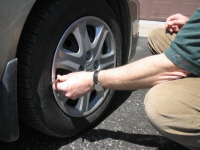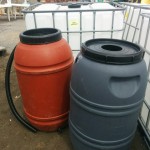A little air to spare our air
 Good reasons for maintaining proper tire pressure on your vehicle:
Good reasons for maintaining proper tire pressure on your vehicle:
- better fuel economy saves you money
- less fuel burned means less greenhouse gas emissions
- better tire life
- improved safety – less risk of blowouts
With properly maintained tires, the average Canadian driver could save two weeks worth of gas every year.
What is the Correct Pressure?
You cannot tell if a tire has the correct pressure by just looking at it. It may look fine but be 20% under-inflated.
For most passenger cars, minivans and mini pickups the recommendations range from 27 to 32 psi. Full-size pickup trucks and sport utility vehicles tend to require 5 to 8 psi more.
70% of the vehicles on the road in Canada have at least one tire that is either over or under-inflated by 10%.
Where to Find It
Look for a sticker (often yellow) on the driver’s side doorjamb, glove compartment or centre console. If you can’t find it, check the owner’s manual.
Do not use the pressure specified on the sidewall of the tire itself – that is a maximum pressure.
A single tire under-inflated by just 44 kPa (8 psi) can increase a vehicle’s fuel consumption by 4% and reduce the life of the tire by 15,000 km.
When to Do It
Check you tire pressure at least once a month, as tires lose up to 2 psi per month. Measure when the tires are cold, i.e. the vehicle has been stationary for three hours and not driven more than 2 km.
Driving increases the pressure. If you have to drive more than 2 km to get air, take a second reading and add the air missing from the first reading.
Do not rely on an automatic tire pressure monitoring system – it provides a warning only when the tire is dangerously low.
Under-inflation is the leading cause of tire failure.
The Effect of Temperature
When outside temperatures go down, your tire pressure will decrease and you will need to add air. In hot weather, you will need to let a little air out. A 5 degree C change in temperature results in a 1 psi change in pressure.
The Gauge
Carry your own gauge as those found at garages are often inaccurate or missing. They can be purchased for as little as $3.00.
How to Check Tire Pressure
- Unscrew plastic cap on air valve and pocket it.
- Press the tire-pressure gauge against the valve and hold it down firmly. If there is a hissing noise, you are letting out air – press down harder.
- Read the measurement on gauge.
- Replace cap.
- Repeat for other tires and for the spare – it loses pressure too!
How to Refill a Tire
- Go to a garage that has pressurized air with a gauge.
- Park so you can reach all four tires with the hose.
- Unscrew plastic cap on tire and pocket it.
- Fit the hose end over the valve.
- Add air by pressing the air pump hose on the valve while squeezing the lever on the end of the hose.
- Recheck pressure.
- Let out some air if you have over-inflated. Press down on the small needle in the centre of the valve with the small knob on your tire pressure gauge, or use a fingernail or pen.
- Replace cap.
- Repeat on other tires.
Proper tire inflation can save drivers between $850 and $1,000 over the typical seven year life of a vehicle in reduced fuel costs and replacement tires.
Tires and the Environment
Under-inflation burns more fuel. Every litre of fuel consumed by a vehicle releases 2.4 kg of C02 into the environment, contributing to climate change.
Improper tire maintenance costs Canadians $500 million a year and releases 1.5 million tonnes of C02 into the atmosphere.
Under inflation leads to shortened tire life. Canadians send 28 million tires per year to landfill.
More information
We recommend www.betiresmart.ca














